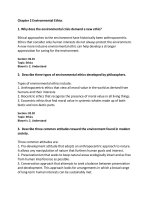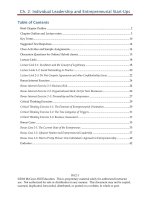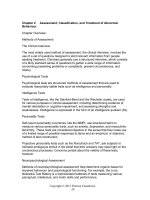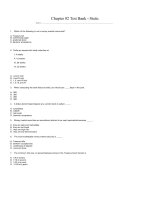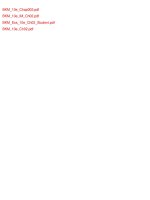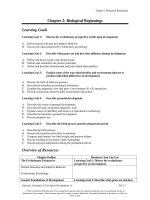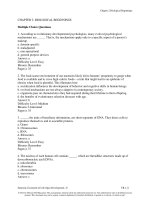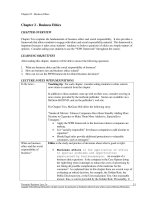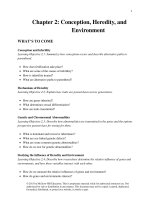Test bank and solution manual of ch02 analyzing business (1)
Bạn đang xem bản rút gọn của tài liệu. Xem và tải ngay bản đầy đủ của tài liệu tại đây (288.7 KB, 18 trang )
CHAPTER 2
ANALYZING BUSINESS TRANSACTIONS
Chapter Opener: Thinking Critically
The individuals in charge of keeping track of these transactions at Southwest as well as in other
companies, are known as accountants. When recording the transactions, accountants are required to
follow a set of rules and regulations known as GAAP.
For every financial transaction that Southwest has, their accountants determine the accounts that were
affected and then they record, report and then analyze these transactions. By doing so they can, at a
specific point in time and over a stipulated period, be able to assess the company’s financial performance
including profitability of the airline, assets owned by the company and of course the amount owed to
creditors and owners.
Fast Facts
• Southwest Airlines opened in 1971 with three planes flying between Houston, Dallas, and San
Antonio. Southwest Airlines currently flies over 100 million passengers a year to 97 cities all
across the country.
• For the fiscal year 2012, the company’s net income was $421 million while its total operating
revenue was $17.09 billion.
• In 2012 Southwest served 63.3 million cans of soda, juices, and water; 14.1 million alcoholic
beverages; 37.2 million bags of pretzels; 88.3 million bags of peanuts; 22.9 million Select-ASnacks; and 45.5million other snacks.
Managerial Implications: Thinking Critically
Answers will vary. Students should mention total assets and the type of assets, the liabilities the business
would be responsible for, and whether the business is making a profit.
Discussion Questions
Note to instructor: These questions are designed to check students’ understanding of new terms,
concepts, and procedures presented in the chapter.
1. Assets = Liabilities + Owner’s Equity
2. Assets: property owned. Liabilities: debts. Owners’ equity: owner’s financial interest.
3. Assets, liabilities, and owner’s equity.
4. Revenue and expenses; net income or loss
5. Beginning-of-period capital balance, additional investments, net income/loss for period, less
withdrawals ending capital balance.
6. Firm name, title of statement, date of statement or the period of time covered
7. Balance sheet shows position at particular date; increase of operations for a period of time
8. Inflow of money/assets resulting from sales or use of property.
9. Outflow of money/assets for costs used to produce revenue.
© 2015 McGraw-Hill Education. This is proprietary material solely for authorized instructor use. Not authorized for sale or
2-1
distribution in any manner.
Discussion Questions (continued)
10. Subtract total expenses from revenue
11. Increases owner's equity
12. a. assets increase, owner’s equity increase
b. one asset increase and another decrease; no change in total assets
c. assets decrease, liabilities decrease
d. assets increase, owner’s equity increase
e. assets decrease, owner’s equity decrease
f. assets decrease, owner’s equity decrease
EXERCISE 2.1
Assets:
Liabilities:
Owners’ Equity
$125,900
$26,225
$99,675
EXERCISE 2.2
1.
2.
3.
4.
5.
$22,240
$19,020
$5,675
$36,725
$8,875
EXERCISE 2.3
Transaction
1.
2.
3.
4.
5.
6.
7.
8.
9.
10.
Assets
I
I
I/D
I/D
I
D
I
I/D
D
D
=
Liabilities
+
Owners’ Equity
I
I
I = Increase (-)
D = Decrease (+)
I
D
I
D
D
EXERCISE 2.4
1.
2.
3.
4.
5.
Assets
Cash
$13,500
Dental Supplies
3,650
Dental Equipment 26,550
Office Furniture
8,000
Total
$51,700
=
=
=
=
=
Liabilities
Accounts Payable $23,180
$23,180
+
Owner’s Equity
+ David Malone, Capital $28,520
+
+
+
+
$28,520
© 2015 McGraw-Hill Education. This is proprietary material solely for authorized instructor use. Not authorized for sale or
2-2
distribution in any manner.
EXERCISE 2.5
Assets
Cash
1.
=
+
Accounts
Receivable
+
Liabilities
+
Equipment
Accounts
= Payable
+
Owner’s Equity
John Amos
Capital
+
Revenue
+$60,000
2.
+22,000
3.
+3,100
4.
-4,600
+22,000
+3,100
+5,050
-4,450
7.
+3,200
8.
Totals
-13,000
$44,250
+5,050
4,450
-3,200
+
$,1,850
+
$26,600
=
-13,000
$9,000
+
$60,000
+
$8,150
-
EXERCISE 2.6
Net income of $23,000
Revenue
Repair Fees …………………………………………..
$51,150
Expenses
Advertising Expense …………………………………………..
$6,300
Salaries Expense …………………………………………..
19,100
Telephone Expense …………………………………………..
1,150
Utilities Expense …………………………………………..
1,600
Total Expenses …………………………………………..
$28,150
Net Income …………………………………………..
$23,000
EXERCISE 2.7
1.
2.
3.
4.
5.
6.
7.
Expenses
+4,600
5.
6.
-
+$60,000
Services were performed for cash.
Equipment was purchased for cash.
A payment was made on the amount owed to a creditor.
An expense was paid in cash.
Cash was received from charge customer.
Services were performed on credit.
An expense was paid in cash.
© 2015 McGraw-Hill Education. This is proprietary material solely for authorized instructor use. Not authorized for sale or
2-3
distribution in any manner.
$4,450
EXERCISE 2.8
Perez Investment Services
Income Statement
Month Ended September 30, 2016
Revenue
Fees Income
77 9 0 0 00
Expenses
Advertising Expense
Salaries Expense
Telephone Expense
Total Expenses
6 5 0 0 00
16 0 0 0 00
8 0 0 00
23 3 0 0 00
54 6 0 0 00
Net Income
EXERCISE 2.9
NetNet
Loss
loss
of of
$1,150
$950
Revenue
Service Revenue …………………………………………..
$5,800
Expenses
Advertising Expense…………………………………………..
$3,100
Telephone Expense…………………………………………..
800
Salaries Expense …………………………………………..
2,600
Cleaning Expense …………………………………………..
450
Total Expense …………………………………………..
$6,950
Net Loss ………………………………………………..
-$1,150
EXERCISE 2.10
Perez Investment Services
Statement of Owner’s Equity
Month Ended September 30, 2016
Alexandria Perez, Capital, September 1, 2016
Net Income for September
Less Withdrawals for September
Increase in Capital
Alexandria Perez, Capital, September 30, 2016
26 7 0 0 00
54 6 0 0 00
9 0 0 0 00
45 6 0 0 00
72 3 0 0 00
© 2015 McGraw-Hill Education. This is proprietary material solely for authorized instructor use. Not authorized for sale or
2-4
distribution in any manner.
EXERCISE 2.10 (continued)
Perez Investment Services
Balance Sheet
September 30, 2016
Assets
Cash
Accounts Receivable
Office Supplies
Office Equipment
Total Assets
33
4
3
37
78
1
0
4
5
0
0
0
0
0
0
0
0
0
0
0
Liabilities
00 Accounts Payable
00
00
Owner's Equity
00 Alexandria Perez, Capital
00 Total Liabilities and Owner's Equity
5 7 0 0 00
72 3 0 0 00
78 0 0 0 00
© 2015 McGraw-Hill Education. This is proprietary material solely for authorized instructor use. Not authorized for sale or
2-5
distribution in any manner.
PROBLEM 2.1A
Cash
+$97,000
-$19,750
1.
2.
3.
4.
5.
6.
7.
8.
9.
10.
11.
Totals
Assets
Accounts
+ Receivable + Supplies
-$11,800
+$30,000
+$8,200
+$6,300
-$4,000
+$3,500
-$6,460
-$9,000
$87,690
= Liabilities + Owner's Equity
Accounts
Owner’s
Capital
+ Equipment = Payable +
+$97,000
+$19,750
+$14,400
+$14,400
-$11,800
+$30,000
+$8,200
+$6,300
-$4,000
-$3,500
+ $6,460
+
$2,800 +
$6,460
+
$34,150 =
$2,600 +
-$9,000
$128,500
Analyze: The ending balance in the Cash account is $87,690.
PROBLEM 2.2A
Cash
Beginning
Balances
Assets
Accounts
Office
+ Receivable + Furniture +
Auto
= Liabilities +
Accounts
= Payable +
Owner’s Equity
M. Dickey
Capital
+
Revenue
-
Expenses
$61,000
+
$16,600
+6,680
+
$35,800
+ $23,500
=
$11,200
+
$91,500
+
$58,600
+6,680
-
$24,400
+
23,280
+
35,800
+1,700
+ $23,500
=
11,200
+
91,500
+
65,280
-
24,400
2.
61,000
-1,700
+
23,280
-11,200
+
37,500
+ $23,500
=
11,200
+
91,500
+
65,280
-
24,400
3.
59,300
+11,200
1.
New
Balances
New
Balances
© 2015 McGraw-Hill Education. This is proprietary material solely for authorized instructor use. Not authorized for sale or
2-6
distribution in any manner.
PROBLEM 2.2A (continued)
Cash
New
Balances
Auto
= Liabilities +
Accounts
= Payable +
Owner’s Equity
M. Dickey
Capital
+
Revenue
-
Expenses
70,500
-880
+
12,080
+
37,500
+ $23,500
=
11,200
+
91,500
+
65,280
-
4.
24,400
+880
69,620
-4,500
+
12,080
+
37,500
+ $23,500
=
11,200
-4,500
+
91,500
+
65,280
-
25,280
5.
+
12,080
+
37,500
+ $23,500
=
6,700
+
91,500
+
65,280
-
6.
65,120
-9,700
25,280
+9,700
55,420
-1,120
+
12,080
+
37,500
+ $23,500
=
6,700
+
91,500
+
65,280
-
7.
34,980
+1,120
54,300
+10,500
+
12,080
+
37,500
+ $23,500
=
6,700
+
91,500
+
65,280
+10,500
-
36,100
8.
+
12,080
+
37,500
+ $23,500
=
6,700
+
91,500
+
75,780
-
9.
64,800
-2,350
36,100
+2,350
62,450
+
+
12,080
+12,500
+
37,500
+ $23,500
=
6,700
+
91,500
+
75,780
+12,500
-
38,450
$62,450
+
$24,580
+
$37,500
+ $23,500
=
$6,700
+
$91,500
+
$88,280
-
$38,450
New
Balances
New
Balances
New
Balances
New
Balances
New
Balances
New
Balances
10.
New
Balances
Assets
+ Accounts +
Office
Receivable
Furniture +
Analyze: Total assets equal $148,030.
© 2015 McGraw-Hill Education. This is proprietary material solely for authorized instructor use. Not authorized for sale or
2-7
distribution in any manner.
PROBLEM 2.3A
Brown Equipment Repair Service
Balance Sheet
February 29, 2016
Assets
Cash
Supplies
Accounts Receivable
Equipment
Total Assets
34
6
13
78
131
3
3
2
0
8
0
8
0
0
8
0
0
0
0
0
Liabilities
00 Accounts Payable
24 0 0 0 00
00
00 Owner's Equity
00 James Brown, Capital
107 8 8 0 00
00 Total Liabilities and Owner's Equity 131 8 8 0 00
Analyze: Owner's Equity is $107,880 at February 29, 2016.
PROBLEM 2.4A
Cotton Cleaning Service
Income Statement
Month Ended May 31, 2016
Revenue
Fees Income
Expenses
Utilities Expense
Salaries Expense
Telephone Expense
Total Expenses
Net Loss
7 8 8 0 00
9 8 0 00
8 9 0 0 00
3 1 4 00
10 1 9 4 00
(2 3 1 4 00)
Cotton Cleaning Service
Statement of Owner's Equity
Month Ended May 31, 2016
Taylor Cotton, Capital, May 1, 2016
Net Loss for May
(2 3 1 4 00)
Less Withdrawal for May
3 0 0 0 00
Decrease in Capital
Taylor Cotton, Capital, May 31, 2016
50 6 0 0 00
5 3 1 4 00)
45 2 8 6 00
© 2015 McGraw-Hill Education. This is proprietary material solely for authorized instructor use. Not authorized for sale or
2-8
distribution in any manner.
PROBLEM 2.4A (continued)
Cotton Cleaning Service
Balance Sheet
May 31, 2016
Assets
Cash
Accounts Receivable
Supplies
Equipment
Total Assets
4
5
5
33
50
6
9
8
8
1
8
0
0
0
8
6
0
0
0
6
00
00
00
00
00
Liabilities
Accounts Payable
Owner's Equity
Taylor Cotton, Capital
Total Liabilities and Owner's Equity
4 9 0 0 00
45 2 8 6 00
50 1 8 6 00
Analyze:
Analyze: The
Theamount
amountofof$43,296
$45,286(Carol
(Taylor
West,
Cotton,
Capital)
Capital)
waswas
transferred
transferred
to the
to balance
the balance
sheet.
sheet.
© 2015 McGraw-Hill Education. This is proprietary material solely for authorized instructor use. Not authorized for sale or
2-9
distribution in any manner.
PROBLEM 2.1B
Cash
+$72,000
-$32,000
1.
2.
3.
4.
5.
6.
7.
8.
9.
10.
11.
Totals
Assets
Accounts
+ Receivable + Supplies
-$6,000
+$12,000
+$8,400
+$7,300
-$5,200
+$5,000
-$6,300
-$10,000
$37,900
= Liabilities + Owner's Equity
Accounts
Owner’s
Capital
+ Equipment = Payable +
+$72,000
+$32,000
+$12,000
+$12,000
-$6,000
+$12,000
+$8,400
+$7,300
-$5,200
-$5,000
+ $6,300
+
$2,300
+
$6,300
+
$44,000
=
$6,000
+
-$10,000
$84,500
Analyze: Transaction 3 increased the Company's debt by $12,000.
PROBLEM 2.2B
Assets
Accounts
+ Receivable +
Supplies
+
Office
Furniture
= Liabilities +
Accounts
= Payable +
$38,000
+
$12,000
+8,000
+
$12,800
+
$24,000
=
$10,000
38,000
-2,880
+
20,000
+
12,800
+
24,000
=
2.
35,120
+10,000
+
20,000
+
12,800
+
24,000
=
3.
Cash
Beginning
Balances
1.
New
Balances
New
Balances
Owner’s Equity
S. Cravens
Capital
+
Revenue
-
Expenses
+
$49,800
+
$52,000
+8,000
-
$25,000
10,000
+
49,800
+
60,000
-
25,000
+2,880
10,000
+
49,800
+
60,000
+10,000
-
27,880
© 2015 McGraw-Hill Education. This is proprietary material solely for authorized instructor use. Not authorized for sale or
2-10
distribution in any manner.
PROBLEM 2.2B (continued)
Cash
New
Balances
Assets
+ Accounts +
Receivable
+
Office
Furniture
Owner’s Equity
S. Cravens
Capital
+
Revenue
-
Expenses
+
20,000
+
12,800
+
24,000
=
10,000
+
49,800
+
70,000
-
4.
45,120
-1,600
27,880
+1,600
43,520
-4,800
+
20,000
+
12,800
+
24,000
=
10,000
-4,800
+
49,800
+
70,000
-
29,480
5.
38,720
-1,920
+
20,000
+
12,800
+
24,000
=
5,200
+
49,800
+
70,000
-
6.
29,480
+1,920
+
20,000
+
12,800
+
24,000
=
5,200
+
49,800
+
70,000
-
7.
36,800
-14,000
31,400
+14,000
+
20,000
+
12,800
+
24,000
=
5,200
+
49,800
+
70,000
+11,200
-
45,400
8.
22,800
+11,200
34,000
+
20,000
+
12,800
+2,000
+
24,000
=
5,200
+2,000
+
49,800
+
81,200
-
45,400
34,000
+6,000
+
+
20,000
-6,000
+
14,800
+
24,000
=
7,200
+
49,800
+
81,200
-
45,400
$40,000
+
$14,000
+
$14,800
+
$24,000
=
$7,200
+
$49,800
+
$81,200
-
$45,400
New
Balances
New
Balances
New
Balances
New
Balances
New
Balances
9.
New
Balances
10.
New
Balances
Supplies
= Liabilities +
Accounts
= Payable +
Analyze: Owner's Equity balance is $85,600; $49,800 + ($81,200 - $45,400).
© 2015 McGraw-Hill Education. This is proprietary material solely for authorized instructor use. Not authorized for sale or
2-11
distribution in any manner.
PROBLEM 2.3B
Smith's Tax Service
Balance Sheet
December 1, 2016
Assets
Liabilities
Cash
50 0 0 0 00
Furniture
10 0 0 0 00
Equipment
12 0 0 0 00 Owner's Equity
Douglas Smith, Capital
72 0 0 0 00
72 0 0 0 00 Total Liabilities and Owner's Equity
72 0 0 0 00
Total Assets
Analyze: The amount reported on the balance sheet for owner’s equity would be $56,000.
PROBLEM 2.4B
Kathryn Proctor, Attorney and Counselor of Law
Income Statement
Month Ended August 31, 2016
Revenue
Fees Income
10 8 0 0 00
Expenses
Utilities Expense
Salaries Expense
Telephone Expense
6 0 0 00
5 4 0 0 00
6 0 0 00
Total Expenses
6 6 0 0 00
Net Income
4 2 0 0 00
Kathryn Proctor, Attorney and Counselor of Law
Statement of Owner's Equity
Month Ended August 31, 2016
Kathryn Proctor, Capital, Aug. 1, 2016
Net Income for August
Less Withdrawals for August
Increase in Capital
Kathryn Proctor, Capital, Aug. 31, 2016
23 2 0 0 00
4 2 0 0 00
1 2 0 0 00
3 0 0 0 00
26 2 0 0 00
Analyze: Net Income of $4,200 was transferred from the income statement.
© 2015 McGraw-Hill Education. This is proprietary material solely for authorized instructor use. Not authorized for sale or
2-12
distribution in any manner.
PROBLEM 2.4B (continued)
Kathryn Proctor, Attorney and Counselor at Law
Balance Sheet
August 31, 2016
Assets
Cash
Accounts Receivable
Supplies
Equipment
Total Assets
4
6
5
10
26
8
6
4
0
8
0
0
0
0
0
0
0
0
0
0
Liabilities
00 Accounts Payable
00
00 Owner's Equity
00 Kathryn Proctor, Capital
00 Total Liabilities and Owner's Equity
6 0 0 00
26 2 0 0 00
26 8 0 0 00
Analyze: Net income of $4,200 was transferred from the income statement.
© 2015 McGraw-Hill Education. This is proprietary material solely for authorized instructor use. Not authorized for sale or
2-13
distribution in any manner.
CRITICAL THINKING PROBLEM 2.1
Determine the balance for Carl Nicholson, April 30, 2016.
Assets
Cash
$30,000
Accounts
+ Receivable + Machinery =
+
$12,000 +
$21,000 =
Accounts
Payable
$13,200
= Liabilities +
Owner’s Equity
C.
Nicholson
C. Nicholson
Drawing
+ Capital
+ Revenue +
?
$6,800 +
$26,800 -
Let Carl Nicholson, Capital = X.
Solving for X:
$63,000 (Total Assets) = $13,200 (Accounts Payable) - $6,800 (Drawing) + $26,800 (Revenue) - $21,490 (Expenses) + X
$63,000 Carl Nicholson, Capital,
April 1, 2016
Advertising Expense
Maintenance Expense
Salaries Expense
Total Expenses
=
$63,000 =
$11,710 =
$51,290 =
$51,290
$11,710
$11,710
X
+
-
X
$11,710
+
X
$3,890
4,600
13,000
$21,490
© 2015 McGraw-Hill Education. This is proprietary material solely for authorized instructor use. Not authorized for sale or
2-14
distribution in any manner.
Expenses
$21,490
CRITICAL THINKING PROBLEM 2.1 (continued)
Carl Nicholson, Certified Public Accountant
Income Statement
Month Ended April 30, 2016
Revenue
Fees Earned
26 8 0 0 00
Expenses
Advertising Expense
Maintenance Expense
Salaries Expense
3 8 9 0 00
4 6 0 0 00
13 0 0 0 00
Total Expenses
21 4 9 0 00
Net Income
5 3 1 0 00
Carl Nicholson, Certified Public Accountant
Statement of Owner's Equity
Month Ended April 30, 2016
Carl Nicholson, Capital, April 1, 2016
Net Income for April
Less Withdrawals for April
51 2 9 0 00
5 3 1 0 00
6 8 0 0 00
Decrease in Capital
(1 4 9 0 00)
Carl Nicholson, Capital, April 30, 2016
49 8 0 0 00
Carl Nicholson, Certified Public Accountant
Balance Sheet
April 30, 2016
Assets
Cash
Accounts Receivable
Equipment
Liabilities
30 0 0 0 00 Accounts Payable
12 0 0 0 00 Owner's Equity
21 0 0 0 00 Carl Nicholson, Capital
Total Assets
63 0 0 0 00 Total Liabilities and Owner's Equity
13 2 0 0 00
49 8 0 0 00
63 0 0 0 00
Analyze:
Analyze:The
The
increase
decrease
in in
owner's
owner's
equity
equity
was
was
$1,450.
$1,490.
© 2015 McGraw-Hill Education. This is proprietary material solely for authorized instructor use. Not authorized for sale or
2-15
distribution in any manner.
CRITICAL THINKING PROBLEM 2.2
Body Builders Fitness Center
Income Statement
Two Months Ended December 31, 2016
Revenue
Fees Earned
Expenses
Rent Expense
Cleaning Expense
Advertising Expense
9 7 6 0 00
8 0 0 0 00
2 1 0 0 00
8 0 0 00
Total Expenses
Net Loss
10 9 0 0 00
(1 1 4 0 00)
Some students may include the warm-up suits as a business expense. If the suits are a type of uniform,
their inclusion is appropriate; if they are to be worn at home and at work, their cost is not a business
expense.
The parking ticket is a personal expense. The cleaning of the studio and the printing of the flyers are
business expenses. Payment of expenses with the owner’s personal credit card would be considered an
additional investment by the owner.
It is not unusual for new businesses to operate at a loss. James should project his income and expenses for
the next several months to determine how much new business he will need to earn an income. Students’
suggestions for improving the accounting system might include opening a business checking account, not
using a personal credit card for business expenses, setting up a filing system for business records, and
purchasing a computer to maintain financial records.
© 2015 McGraw-Hill Education. This is proprietary material solely for authorized instructor use. Not authorized for sale or
2-16
distribution in any manner.
SOLUTIONS TO BUSINESS CONNECTIONS
Managerial Focus:
1. Not necessarily. Reinvestments in assets or use of cash to pay debts affect cash. In addition, sales or
revenue may have been "on account."
2. No. Early development is expensive, risky, and time consuming. Profits may not be achieved for a
year or more.
3. The firm’s obligations must be met as they become due.
4. Organized financial information can be used to evaluate operating efficiency and to make decisions
about current and future activities.
Ethical
JuliaDilemma:
should not record the sale until she receives the purchase order from the customer and the
goods are shipped. If she enters the sale and for some reason the customer doesn’t make the order
or the goods are not available for shipment, Carol would need to pay the bonus back. Julia’s job
would be in jeopardy.
Financial Statement Analysis:
1. Southwest Airlines Co., Consolidated Statement of Income, Years Ended December 31,
2. Passenger, Freight, Other.
3. Statement of Owner’s Equity (Consolidated Statement of Stockholders’ Equity).
4. Total operating revenue was $4.2 billion for the quarter ended December 31, 2012.
5. See current topic on website.
Internet Connection:
Macy’s, Bloomingdales, and now May is included in the Federated Corporation. Shopping online is
on every home page. To record an online sale it must debit a credit card receivable and credit sales.
A general job announcement and requirements are given at the site.
Team Work:
Accounts Payable Clerk would use Purchases (Increase), A/P (increase and decrease) and Cash
(decrease). Accounts Receivable Clerk would use Sales (increase), A/R (increase and decrease) and
Cash (increase). Full charge bookkeeper would use accounts Cash (increase and decrease), Bank
Charges (increase) and Miscellaneous account (increase), Interest Income (increase), Interest
Expense (increase). Accurate numbers are developed when it is determined that all transactions
have been entered and that total assets equal total liabilities plus owner’s equity.
© 2015 McGraw-Hill Education. This is proprietary material solely for authorized instructor use. Not authorized for sale or
2-17
distribution in any manner.
SOLUTIONS TO PRACTICE TEST
Part A True-False
1. TRUE
2. TRUE
3. FALSE
4. TRUE
5. FALSE
6.
7.
8.
9.
10.
TRUE
FALSE
TRUE
FALSE
TRUE
Part B Matching
1. b
2. f
3. e
4. c
5. h
6.
7.
8.
d
g
a
Part C Completion
1. profit
2. credit or on account
3. reduced or decreased
4. assets
5. asset or property
6. equal
7. accounts payable or liability
8. analyze
© 2015 McGraw-Hill Education. This is proprietary material solely for authorized instructor use. Not authorized for sale or
2-18
distribution in any manner.
